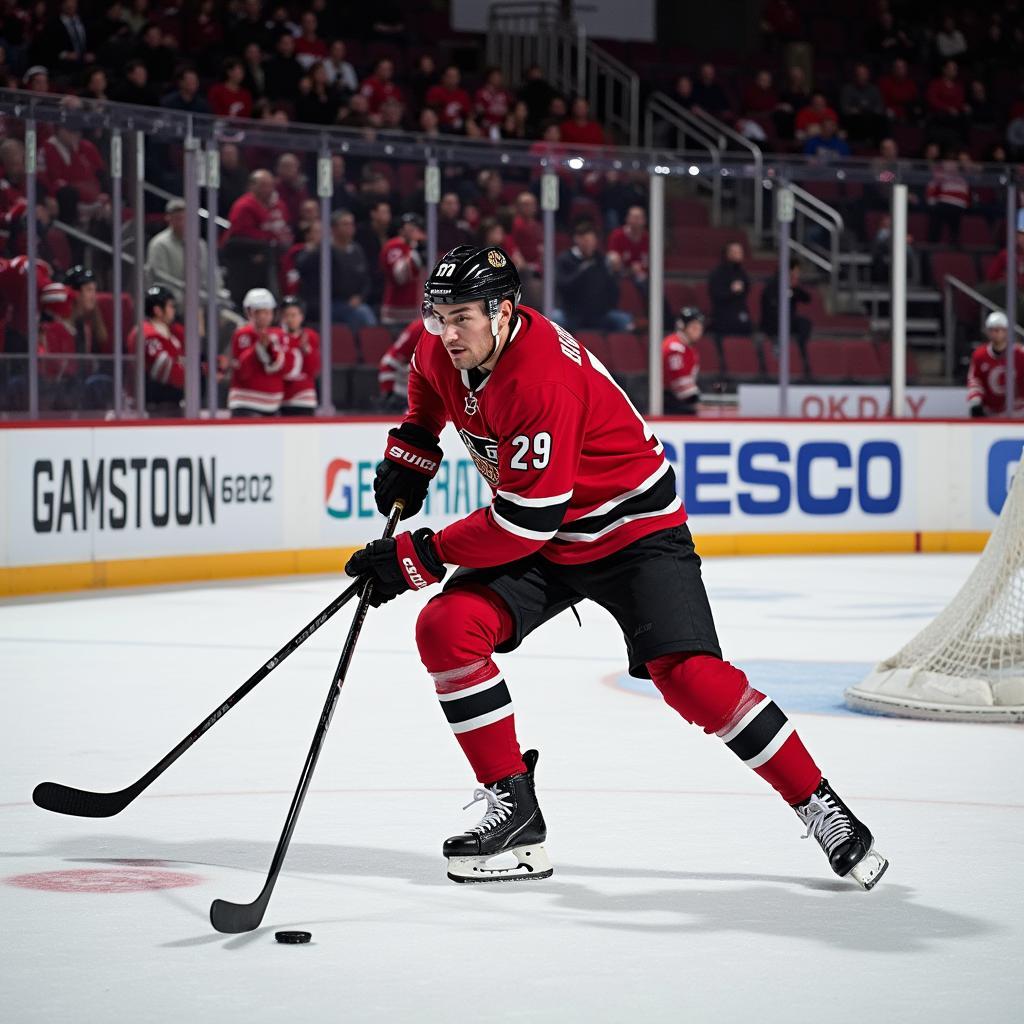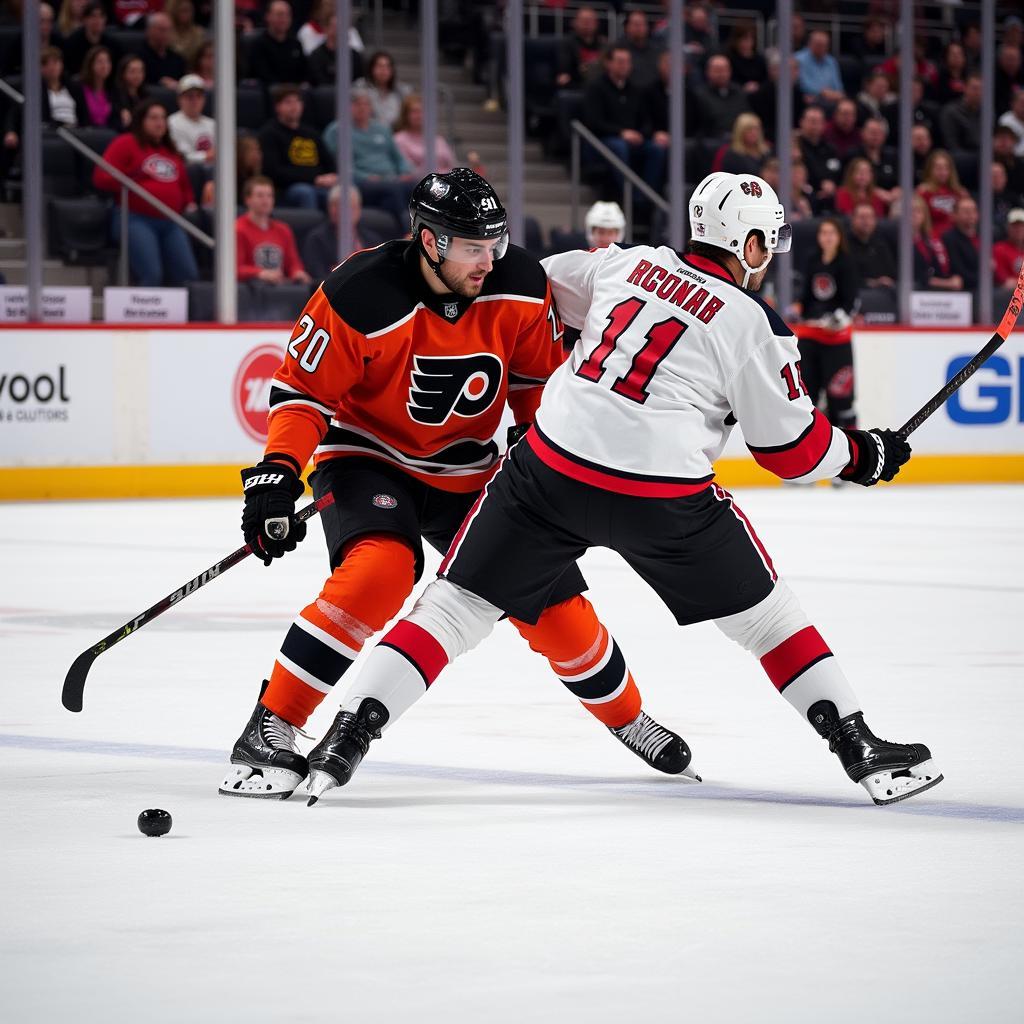Building the perfect hockey player is a combination of natural talent, dedicated training, and strategic skill development. Whether you’re a power forward looking to dominate in front of the net or a speedy winger aiming to outmaneuver the competition, understanding the key physical and mental attributes for different player builds is essential. This guide delves into the optimal Hockey Player Builds, providing insights into training, nutrition, and skill development to help you reach your full potential on the ice.
The Power Forward Build: Strength and Net-Front Presence
 Hockey Player with Power Forward Build
Hockey Player with Power Forward Build
The power forward, often positioned in front of the net, thrives on physicality and a knack for scoring gritty goals. They are known for their strength, hand-eye coordination, and ability to win puck battles in tight spaces.
Key Attributes:
- Strength and Power: Focus on building upper and lower body strength through weight training exercises like squats, deadlifts, and bench presses.
- Hand-Eye Coordination: Improve puck handling skills through drills that involve hand-eye coordination such as rapid passing and deflecting pucks in front of the net.
- Balance and Stability: Enhance balance and stability through core strengthening exercises like planks, Russian twists, and medicine ball throws to maintain position in front of the goal.
The Speedy Winger Build: Agility and Puck Control
The speedy winger, known for their blistering speed and agility, excels at creating scoring opportunities by outmaneuvering opponents on the rush. Their ability to handle the puck at high speeds while maintaining control is crucial for their success.
Key Attributes:
- Speed and Agility: Prioritize plyometric exercises like box jumps, jump squats, and agility ladder drills to enhance explosiveness and quick changes in direction.
- Puck Control: Focus on puck handling drills at varying speeds, stickhandling through cones and obstacles to improve puck control while skating at high speeds.
- Vision and Passing: Develop playmaking abilities by practicing precise passes and learning to anticipate the movement of teammates and opponents alike.
The Two-Way Forward Build: Versatility and Hockey IQ
 Versatile Hockey Player Demonstrating Two-Way Skills
Versatile Hockey Player Demonstrating Two-Way Skills
The two-way forward is a versatile player who excels in both offensive and defensive zones. They possess a high hockey IQ, understanding the game’s nuances and making smart plays in all situations.
Key Attributes:
- Stamina and Endurance: Engage in interval training and on-ice drills that simulate game situations to improve stamina and endurance for playing in both offensive and defensive zones effectively.
- Defensive Awareness: Develop strong defensive positioning and stick-checking techniques through drills that emphasize backchecking, gap control, and one-on-one defensive scenarios.
- Hockey Sense: Study the game and analyze different situations to enhance hockey IQ and decision-making abilities on the ice.
The Defensive Defenseman Build: Physicality and Defensive Prowess
Defensive defensemen are the backbone of a strong defensive unit, known for their physicality, shot-blocking willingness, and ability to shut down opposing offenses.
Key Attributes:
- Strength and Size: Prioritize weight training to build a strong physique, focusing on compound exercises to withstand physicality in front of the net and along the boards.
- Defensive Awareness: Master defensive positioning, gap control, and stick-checking techniques to limit scoring opportunities for the opposition.
- Shot Blocking: Develop the courage and technique to block shots effectively, understanding angles and positioning to minimize the impact.
The Offensive Defenseman Build: Puck-Moving and Offensive Instincts
Offensive defensemen contribute significantly to the offense by joining the rush, making plays from the point, and utilizing their strong puck-handling skills.
Key Attributes:
- Skating and Edgework: Focus on skating drills, particularly edgework, to maneuver effectively in the offensive zone and contribute to offensive plays.
- Passing and Vision: Develop accurate passing and the ability to anticipate plays to create scoring opportunities from the blue line.
- Shooting Accuracy: Practice shooting from the point, working on power and accuracy to generate scoring chances during offensive possessions.
Conclusion: Building Your Path to Success
No single hockey player build guarantees success. It’s the dedication to training, nutrition, and skill development, alongside a deep understanding of your strengths and weaknesses, that paves the way to becoming a dominant force on the ice. Remember, the journey to becoming a complete hockey player is an ongoing process of learning, adapting, and refining your skills.





